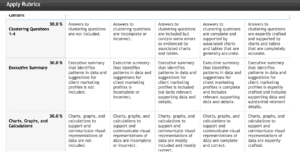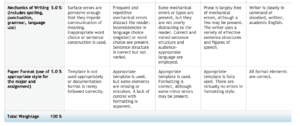Interpret the clusters with respect to the quantitative variables that were used in forming the clusters.
The purpose of this assignment is to perform cluster analysis and analyze clusters in a data set to determine whether or not the information generated can be used to address a specific business problem.
For this assignment, you will use the “Wholesale Customers” data set from the Topic Materials. Most data categories are self-explanatory. Clarifying notes are as follows.
Fresh: Annual spending (in $1000s) on fresh products
Milk: Annual spending (in $1000s) on milk products
Grocery: Annual spending (in $1000s) on grocery products
Frozen: Annual spending (in $1000s) on frozen products
Detergents_Paper: Annual spending (in $1000s) on detergents and paper products
Delicatessen: Annual spending (in $1000s) on delicatessen products
Client_Type: Type of client – either HoReCa (Hotel/Restaurant/Café) or Retail
Region: Region of client – either Lisbon, Oporto, or Other
A wholesale distributor wants to understand the purchasing profiles of its clients. If a finite set of distinct profiles were defined, then a marketing strategy could be designed specifically for each set of similar clients. The company has compiled a data set that includes annual client spending on diverse product categories. You have been tasked with analyzing the data to determine what patterns emerge and how these patterns can be used to create specific client marketing profiles.
Use k-means clustering to explore and analyze the data set by using only the quantitative variables to cluster the clients.
Question 1: Explain the process you used to define the clusters such as the number of clusters formed, the specific variables used, etc. Include the “Cluster Sizes” and “Predictor Importance” outputs when submitting the answer.
Question 2: Interpret the clusters with respect to the quantitative variables that were used in forming the clusters. Include the “Clusters” output when submitting the answer.
Question 3: Discuss whether there is a pattern in the clusters with respect to the qualitative variables (i.e., Client_Type or Region). Include the charts illustrating these patterns when submitting the answer.
Question 4: Provide an appropriate name for each cluster using any or all of the variables in the data set.
Question 5: Based upon your analysis, what patterns emerged and how can these patterns be used to create specific client marketing profiles? Include discussion of the characteristics for each profile. Present your finding in the form of a 250-word executive summary that includes relevant data, charts, and tables.
mis_655_rs_wholesale_customers

Solution preview
K-means clustering technique divides data sets into k clusters defined by their center point that is their means. I used fresh, milk, grocery, frozen, detergents paper, and delicatessen as my data points around which I am going to form my clusters. The client types are grouped into two classes; hotel/restaurant/café and retails……………………..
APA
1052 words
